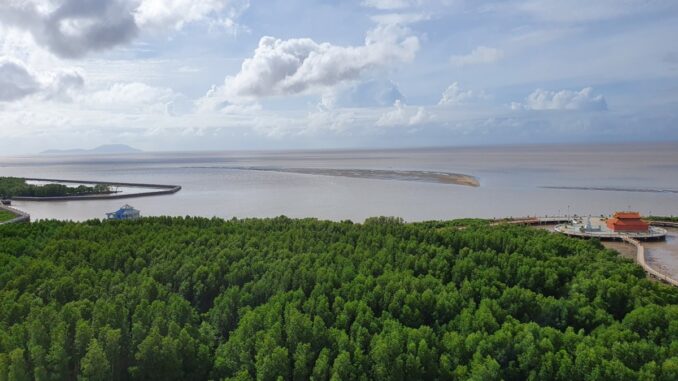
Learn about mangroves, make fences to grow fish forests, and experience the life of indigenous people in just 2 weekends.
I just had an experience trip to the southernmost point of the country with complete strangers. Unlike previous vacation trips and beautiful photography, coming to Ca Mau cape, I want to see and contribute my energy to creating mangroves.

Day 1: Experience creating forests, living like a local
Departing from Saigon, after 8 hours of night driving, our group was in Ca Mau at 5 o’clock. After resting, the shuttle bus took us to Ca Mau Cape National Park at 8am.

Here, we met the officials, heard the story about the mam tree and learned about the mangrove forest on a canoe. At 10 o’clock, we reached the forest area. 50 hectares of mudflats in the core area of Ca Mau Cape National Park, belonging to the Ca Mau World Biosphere Reserve have been zoned for farming, promoting natural regeneration to transform into forests.
Here, we experience mangrove planting, organized by Gaia Nature Conservation. Activities contribute to increasing the forest area, responding to climate change, combating saltwater intrusion and improving the economic and ecological values of the forest. In particular, this will be the residence of many rare wildlife species.
We are directly making fences, in the system of keeping white fish sauce seeds. The system has a length of 2,900 m, made from more than 11,000 melaleuca poles and 2,900 m of nets are set up. The fence retains the fallen fruit from the mother tree, to grow into a young fish tree and grow into a mangrove forest, after 6 years.
The forest is monitored, monitored and cared for by the National Park Management Board for 6 years, to ensure stable development. The goal will be for at least 185,000 fish sauce trees to grow healthy.


After completing the 20m fence, we had to move because of the rising water. The way back to the homestay is a journey to discover the mysterious nooks and crannies of the mangrove forest, where over 50 years old mangroves grow luxuriantly and green.
Coming to Ba Su homestay, located right in the National Park, we have the opportunity to learn about life and experience the river life of the Ca Mau people. Homestay is designed in the form of a house on stilts right on the water, with 2 guest houses, 1 dining room, 1 kitchen and 4 large rooms, specialized for groups of tourists with the number of 8 people or more. Surrounded by the green color of mangroves.


After having lunch with typical local dishes, we were able to go on a boat trip (a type of canoe), challenging to set up crab roofs. In the evening, we catch three ki and enjoy the starry sky, right on the 1 km long river where the homestay is located.
At 6pm, we gathered around a small fire, enjoying the quiet countryside atmosphere, in intimate stories, besides the warm warmth of mangrove peat and the smell of potatoes and roasted corn with the flavor of the West. .
Day 2: Check in the southernmost point of the country
Early in the morning, we were awakened by the sound of migratory birds. The air in the land at the end of the country brings a feeling of refreshment and freshness.
Everyone has their own time in the morning to visit the garden and talk to the locals. People can live in the National Park but have the obligation to preserve and protect the forest.
Ms. Diem (1992), the homestay owner said: “The ratio of forest and water surface must always be maintained at 70-30. In addition to farming shrimp and moat farming, in recent years when tourism has developed, we have also business more follow-up services such as homestays, and tours to experience local people’s life. The homestay was created from a house more than 90 years old from my grandmother’s time.”

After talking with Diem about people’s lives, we picked butterfly pea flowers, cooked hot tea at the beginning of the day to prepare for check-out of the homestay, and continued the journey.
Having come to Dat Mui, it is impossible not to stop by milestone 0. At Ca Mau Cape National Tourist Area, we heard about the land that can walk, about the daily “blooming” journey of this land.
Ms. Tu, the tour guide of the resort, took us to visit the GPS0001 National Coordinate Landmark, the symbol of the small landscape, the image of a windy boat that always faces the sea, the End Point of Ho Chi Minh Road. In addition, there is the temple of Lac Long Quan, the statue of Au Co’s mother, the breakwater, and the Hanoi Flag Tower. We can enjoy the panoramic view of the bordering point between the East and West seas and enjoy delicious specialties.

The flagpole has 10 floors. Which, the 1st and 2nd floors display the natural succession formation process of Dat Mui. Including more than 180 images of all kinds and 2 models of mangrove and brackish mangrove ecosystems in Ca Mau. The 3rd floor has the theme of the typical cultural heritage of Thang Long – Hanoi, introducing core cultural heritage values of the land of thousand of years of civilization, with 16 special national relics and 12 artifacts. The group of artifacts is national treasures, three intangible cultural heritages recognized by UNESCO, and registered in the intangible cultural heritage of humanity.
On the high floors of the flagpole, we can enjoy the panoramic view of the Ca Mau mangrove forest, the vast East Sea, and the beautiful and poetic island cluster of Hon Khoai.

Photo: Gaia Nature Conservation, Thanh Hang
